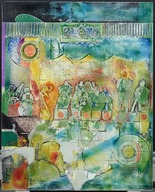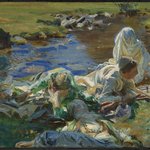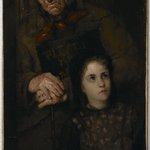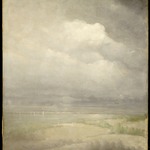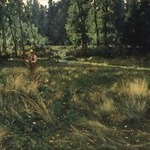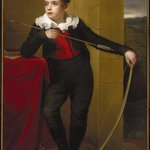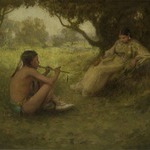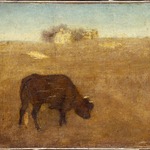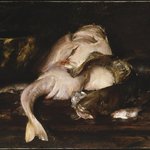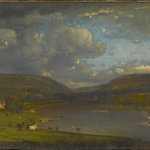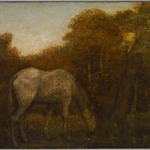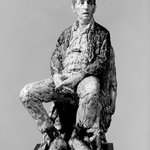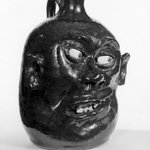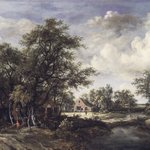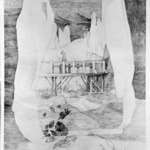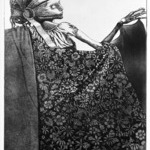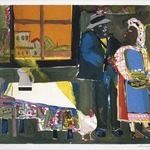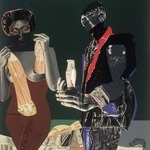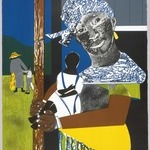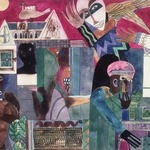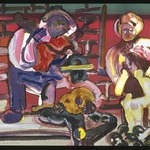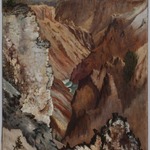At Connie's Inn, from the "Of the Blues" series
Romare Bearden
Contemporary Art
Music played an important role in Romare Bearden's art. He especially loved jazz, and his method as a visual artist was based in part on what he had learned from jazz musicians about improvisation. As in jazz, the unpredictable repetitions and juxtapositions of shapes, textures, and colors in his art create startling, unexpected visual rhythms. As Bearden once said about being an artist: "You must become a blues singer—only you sing on the canvas. You improvise—you find the rhythm and catch it good, and structure as you go along—then the song is you. Music has always been important for me the way it has been important for many Blacks. Blacks have made their own sound, their own musical language like jazz. It is theirs and they identify with it. In a world of constantly changing identities, certain forms of music represent a solid identity for Blacks."
MEDIUM
Collage (with acrylic and lacquer) on masonite panel
DATES
1974
DIMENSIONS
49 7/8 × 39 15/16 in. (126.7 × 101.4 cm)
frame: 52 × 42 × 3 in. (132.1 × 106.7 × 7.6 cm)
(show scale)
SIGNATURE
Signed lower left (blue): "romare bearden"
ACCESSION NUMBER
75.74
CREDIT LINE
John B. Woodward Memorial Fund
MUSEUM LOCATION
This item is not on view
CAPTION
Romare Bearden (American, 1911–1988). At Connie's Inn, from the "Of the Blues" series, 1974. Collage (with acrylic and lacquer) on masonite panel, 49 7/8 × 39 15/16 in. (126.7 × 101.4 cm). Brooklyn Museum, John B. Woodward Memorial Fund, 75.74. © artist or artist's estate (Photo: Brooklyn Museum, 75.74_PS2.jpg)
IMAGE
overall, 75.74_PS2.jpg. Brooklyn Museum photograph, 2009
"CUR" at the beginning of an image file name means that the image was created by a curatorial staff member. These study images may be digital point-and-shoot photographs, when we don\'t yet have high-quality studio photography, or they may be scans of older negatives, slides, or photographic prints, providing historical documentation of the object.
RIGHTS STATEMENT
© artist or artist's estate
Copyright for this work may be controlled by the artist, the artist's estate, or other rights holders. A more detailed analysis of its rights history may, however, place it in the public domain.
The Museum does not warrant that the use of this work will not infringe on the rights of third parties. It is your responsibility to determine and satisfy copyright or other use restrictions before copying, transmitting, or making other use of protected items beyond that allowed by "fair use," as such term is understood under the United States Copyright Act.
For further information about copyright, we recommend resources at the
United States Library of Congress,
Cornell University,
Copyright and Cultural Institutions: Guidelines for U.S. Libraries, Archives, and Museums, and
Copyright Watch.
For more information about the Museum's rights project, including how rights types are assigned, please see our
blog posts on copyright.
If you have any information regarding this work and rights to it, please contact
copyright@brooklynmuseum.org.
RECORD COMPLETENESS
Not every record you will find here is complete. More information is available for some works than for others, and some entries have been updated more recently. Records are frequently reviewed and revised, and
we welcome any additional information you might have.



